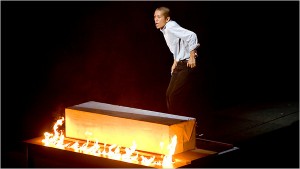JQ Magazine: Theatre Review – Amon Miyamoto’s ‘The Temple of the Golden Pavilion’

Go Morita in a scene from 'The Temple of the Golden Pavilion' at New York's Lincoln Center Festival. (Stephanie Berger)
By Lyle Sylvander (Yokohama-shi, 2001-02) for JQ magazine. Lyle is entering a master’s program at the School of International and Public Affairs at Columbia University (MIA 2013) and has been writing for the JET Alumni Association since 2004. He is also the goalkeeper for FC Japan, a NYC-based soccer team.
In 1950, a young Buddhist monk committed a notorious act of arson and destroyed the ancient Kinkakuji Temple in Kyoto, Japan. Yukio Mishima, Japan’s preeminent novelist at the time, fictionalized the events in Kinkakuji, published in 1956 and translated into English as The Temple of the Golden Pavilion in 1959. While the actual arsonist was diagnosed with paranoid schizophrenia, Mishima presented an elaborately detailed psychological study of a disturbed man, incorporating elements of Buddhist and ancient Greek philosophical reflections on the impermanence of beauty and the conflicts between idealism and reality. The novel helped cement Mishima’s worldwide literary reputation and inspired numerous adaptations, including an opera, a modern dance ballet and two film versions.
Now, the director Amon Miyamoto, previously represented in New York by his production of Stephen Sondheim’s Pacific Overtures, has adapted the story into a full-fledged theatrical production. Having premiered last year at Miyamoto’s Kanagawa Arts Theatre (KAAT) in Yokohama, the production was presented intact by the annual Lincoln Center Festival in New York from July 21-24 with its original cast, led by J-pop star Go Morita of the boy band V6.
In presenting his version of the story, Miyamoto (who co-wrote the script with Chihiro Ito) relies on an arsenal of visual conventions, from multimedia projections to Western theatrical blocking to Japanese austerity. Most of the play is presented on a wooden stage suggestive of an old classroom, a fitting visual component of the temple grounds’ claustrophobic enclave. Mizoguchi, the monk’s name in Mishima’s version, is played by Morita as an awkward stutterer who creates a vibrant interior world at odds with his disappointing reality.
Miyamoto is most successful in realizing the psychological dynamism so evident in the novel by representing his interior machinations theatrically—the small stage functions dually as Mizoguchi’s mind, a mental arena where his neuroses and complexes assume a tangible form and battle each other. Sexual repression, aesthetic rapture, a dangerous idealism of history and Japanese nationalism, and the tragic struggle between the Dionysian and Apollonian aesthetic propel Mizoguchi’s mind toward its tragic end. Along the way, he is manipulated by his clubfooted friend Kashiwagi, who uses his malady as way to get sympathy from women.
The play’s visuals were effective in two ways. They told the literal aspects of the story well, an example being the screen projections when Mizoguchi was traveling by train and the scene in Gion. But they also demonstrated what was going on in his mind—the visual representation of the electronic static going on his mind—the anxiety, tension and confusion that drove him to desperate measures. This all built up to the climax, where the audience inside the Rose Theater is engulfed in the golden red light, itself both literal (the burning of the golden temple) and the image of transient perfect beauty that he is so desperate to find.
This impressive staging of The Temple of the Golden Pavilion is a much more demanding work than causal theatergoers may be used to, but fans of Mishima and his novel will find much to savor.
For more on The Temple of the Golden Pavilion, click here.


Comments are closed.